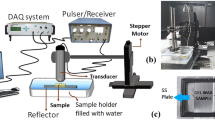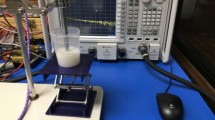Abstract
Materials with acoustic properties similar to soft-tissue are essential as tissue-mimicking materials (TMMs) for diagnostic ultrasound (US). The velocity (cus), acoustic impedance (AI) and attenuation coefficient of US (µ) in a material collectively define its acoustic property. In this work, the acoustic properties of polychloroprene rubber, beeswax, and Carbomer-gel are determined. The pulse-echo technique is used to estimate cus and µ. The product of a sample density (ρ) and cus gives its AI. Using a reference based on the International Commission on Radiation Units and Measurements Report-61, Tissue Substitutes, Phantoms and Computational Modelling in Medical Ultrasound, the results are evaluated. The acceptance criteria are 1.043 ± 0.021 g/cm3 (ρ), 1561 ± 31.22 m/s (cus), 1.63 ± 0.065 MRayls (AI) and µ within 0.5–0.7 dB/cm/MHz. Sample computerized tomography (CT) and US scanning are performed to evaluate their similarities (contrast and speckle pattern) with respective images of the human liver (a clinical soft-tissue). The average errors in measuring cus and µ were 0.14% and 1.2% respectively. From the present findings, acoustic properties of polychloroprene and beeswax are unacceptable. However, the results of Carbomer-gel ρ = 1.03 g/cm3, cus = 1567 m/s, AI = 1.61 MRayls are satisfactory and µ = 0.73 dB/cm/MHz, is higher than the reference (4.3%). Carbomer-gel could produce CT and US images, efficiently mimicking the respective liver images. Carbomer-gel containing 95% water is a low-cost material with a simple formulation. Present results suggest, Carbomer- gel mimics soft-tissue and can be used as a TMM for diagnostic US.





Similar content being viewed by others
References
Bude RO, Adler RS (1995) An easily made, low-cost, tissue-like ultrasound phantom material. J Clin Ultrasound 23:271–273
Annon LOMC, Agan ANJF, Rowne JAEB (2011) Novel tissue mimicking materials for high frequency breast ultrasound phantoms. J Clin Ultrasound 37:122–135. https://doi.org/10.1016/j.ultrasmedbio.2010.10.005
Earle M, De PG, Devos E (2016) African federation for emergency medicine African journal of emergency medicine agar ultrasound phantoms for low-cost training without refrigeration Fantoˆmes d’e´chographie utilisant l’agar-agar pour une formation a` faible couˆt, sans re´frige´ration. Afr J Emerg Med 6:18–23. https://doi.org/10.1016/j.afjem.2015.09.003
Madsen EL, Frank GR, Dong F (1998) Liquid or solid ultrasonically tissue-mimicking materials with very low scatter. Ultrasound Med Biol 24:535–542. https://doi.org/10.1016/S0301-5629(98)00013-1
Rowne JEB, Amnarine KVR, Atson AJW, Oskins PRH (2003) Original contribution assessment of the acoustic properties of common tissue- mimicking test phantoms. Ultrasound Med Biol 29:1053–1060. https://doi.org/10.1016/S0301-5629(03)00053-X
Committee ATS (1990) Standard methods for measuring performance of pulse-echo ultrasound imaging equipment: American Institute of Ultrasound in Medicine Standard. AIUM, Laurel
Goodsitt MM, Carson PL, Witt S, Hykes DL, Kofler JM (1998) Real-time B-mode ultrasound quality control test procedures: report of AAPM ultrasound task group no. 1. Med Phys 25:1385–1406. https://doi.org/10.1118/1.598404
Garu PK, Chaki TK (2012) Acoustic & mechanical properties of neoprene rubber for encapsulation of underwater transducers. Int J Sci Eng Technol 237:231–237
ASTM D2240-03 (2003) Standard test method for rubber property-Durometer hardness. https://www.astm.org/DATABASE.CART/HISTORICAL/D2240-03.htm. Accessed 13 Aug 2020
Islam MT, Rodriguez-Hornedo N, Ciotti S, Ackermann C (2004) Rheological characterization of topical carbomer gels neutralized to different pH. Pharm Res 21:1192–1199
Zhu W, Guo C, Yu A, Gao Y, Cao F, Zhai G (2009) Microemulsion-based hydrogel formulation of penciclovir for topical delivery. Int J Pharm 378:152–158
Bushberg JT, Boone JM (2011) The essential physics of medical imaging. Lippincott Williams & Wilkins, Philadelphia
Hendee WR, Ritenour ER (2003) Medical imaging physics. Wiley, Hoboken
Mast TD (2000) Empirical relationships between acoustic parameters in human soft tissues. Acoust Res Lett Online 1:37–42. https://doi.org/10.1121/1.1336896
International Commission on Radiation and Measurements ICRU (1998) Tissue substitutes, phantoms and computational modelling in medical ultrasound. ICRU
Cameron J (1991) Physical properties of tissue. A comprehensive reference book, edited by Francis A. Duck. Med Phys 18:834
Testing RF, Procedure T, Bude R, Adler RS, Metcalfe BSC, Evans JA et al (2010) A review of tissue substitutes for ultrasound imaging. Ultrasound Med Biol 15:1053–1060. https://doi.org/10.1088/0031-9155/60/21/L23
de Kock EA, Schreuder AN, Schneider U (1996) The calibration of CT Hounsfield units for radiotherapy treatment planning. Phys Med Biol 41:1524–1527. https://doi.org/10.1088/0031-9155/41/1/009
Cozzi L, Fogliata A, Buffa F, Bieri S (1998) Dosimetric impact of computed tomography calibration on a commercial treatment planning system for external radiation therapy. Radiother Oncol 48:335–338. https://doi.org/10.1016/S0167-8140(98)00072-3
Huang J, Nissen JA, Bodegom E (1992) Diffraction of light by a focused ultrasonic wave. J Appl Phys 71:70–75
Suheshkumar Singh M (2006) Ultrasound assisted optical tomography for characterization of optical and mechanical properties of soft biological tissues. Indian Institute of Science (IISc), Bangalore
https://www.nde-ed.org/GeneralResources/MaterialProperties/UT/ut_matlprop_metals.htm n.d. Accessed 6 June 2020
Capps RN (2005) Influence of carbon black fillers on acoustic properties of polychloroprene (neoprene) elastomers. J Acoust Soc Am 78:406–413. https://doi.org/10.1121/1.392462
Maneas E, Xia W, Nikitichev DI, Daher B, Manimaran M, Wong RYJ et al (2018) Anatomically realistic ultrasound phantoms using gel wax with 3D printed moulds. Phys Med Biol 63:aa9e2c. https://doi.org/10.1088/1361-6560/aa9e2c
Vieira SL, Pavan TZ, Junior JE, Carneiro AAO (2013) Paraffin-gel tissue-mimicking material for ultrasound-guided needle biopsy phantom. Ultrasound Med Biol 39:2477–2484. https://doi.org/10.1016/j.ultrasmedbio.2013.06.008
Oudry J, Bastard C, Miette V, Willinger R, Sandrin L (2009) Copolymer-in-oil phantom materials for elastography. Ultrasound Med Biol 35:1185–1197. https://doi.org/10.1016/j.ultrasmedbio.2009.01.012
Acknowledgements
We gratefully acknowledge Dr. Naveen P. Kumar, Regional Cancer Center, Thiruvananthapuram, Kerala (India) for performing the ultrasound scans. We are grateful to Prof. M.R. Sarathchandradas, Sree Chitra Thirunal College of Engineering, Thiruvananthapuram, Kerala (India) for helpful discussions regarding the velocity measurements. We thank Vajra Rubber Products (P) Ltd. Trichur, Kerala (India) for preparing the polychloroprene for testing.
Funding
This research did not receive any specific grant from funding agencies in the public, commercial, or not-for-profit sectors.
Author information
Authors and Affiliations
Corresponding author
Ethics declarations
Conflict of interest
The authors have no conflicts of interest to declare.
Ethical approval
This study was approved by the Institutional Scientific Review Committee.
Informed consent
An informed consent of the patient was taken for using the diagnostic images in this study.
Additional information
Publisher's Note
Springer Nature remains neutral with regard to jurisdictional claims in published maps and institutional affiliations.
Rights and permissions
About this article
Cite this article
Phani, D., Varadarajulu, R.K., Thomas, A. et al. Acoustic and ultrasonographic characterization of polychloroprene, beeswax, and carbomer-gel to mimic soft-tissue for diagnostic ultrasound. Phys Eng Sci Med 43, 1171–1181 (2020). https://doi.org/10.1007/s13246-020-00919-7
Received:
Accepted:
Published:
Issue Date:
DOI: https://doi.org/10.1007/s13246-020-00919-7




